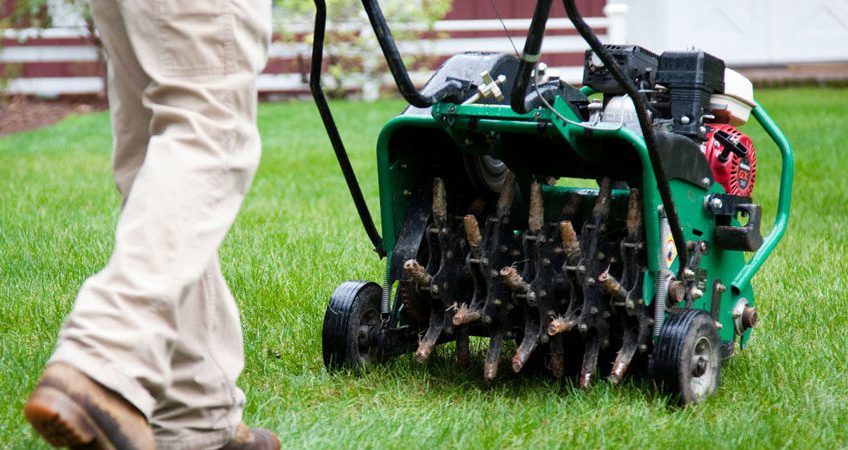Keeping your lawn green and healthy is year-round work, and fall turf care is the way to make the most of it.
Expensive fertilizers and constant watering might be necessary for the hot summer months. But when temperatures drop, the careful application of fall turf care will help your lawn bounce back from the summer heat, survive the coming winter and, most importantly, pop the following spring.
You may know the common terms of fall turf care – core aeration, overseeding and dethatching. But do you know how each helps your lawn? Read on to discover the basics of fall turf care, and see how each can turn your lawn into an award winner.
Dethatching | Clear the Debris
Healthy lawns start with healthy soil, and that soil will want for nutrients and water if it’s not cleared properly.
Over time, the buildup of old grass clippings and other debris creates a matted surface atop your yard. While the grass itself may hide this mess of dead plant material from view, a thin lawn that doesn’t respond to fertilizers and deep watering is a sure sign of excess thatch.
Dethatching can be a drag, manually speaking. Raking out thatch by hand works well if you’ve got the back for it. For speedier applications, machines make quick work of removing thatch over bigger areas.
For cool-season lawns like you’ll find in Pittsburgh, the window for dethatching can be narrow. Fall turf care programs make sure your lawn gets this disruptive treatment when grass is out of summer dormancy and able to recover with new and better growth.
Core Aeration | Breathe Deep
Dethatching is important, but only scrapes the surface (literally). Addressing the health of the soil under your turf is paramount to a full, green lawn.
Over time, lawns fall victim to soil compaction. A combination of foot traffic and old grass clippings can harden the soil and choke out established grass. The first step in reclaiming the space is breaking loose the debris and thatch that builds up over time. Where dethatching starts that process, core aeration takes it below ground.
“Plugs” of dirt and thatch are pulled mechanically from the ground, returning nutrients to the ground slowly as the plugs break apart. As they do, the space that’s opened up allows for the expansion of the soil around it.
In addition to reducing compaction, which can prevent new growth from taking place, this important process creates space for air, water and new grass seed to penetrate the surface.
To keep the ecosystem of your turf healthy, air and water are necessary in equal measure. Aeration is the best way to make sure those elements get to the roots of your lawn, where they matter most.
Room to Grow | Overseeding & Slice-Seeding
Once the soil is loose and clear of debris, it’s time to supplement your existing turf with new seed.
Fall is as good a growing season as the spring. New seed will respond quickly to cooler temperatures, and fall typically brings with it more rain.
It’s also important to introduce new seed to recently upturned soil. Establishing your new turf in the fall is critical to preparing the lawn for spring. It also allows for turf to take over and choke out common lawn weeds, most of which begin to recede as temperatures cool.
Overseeding is the broadcasting of seed across the entire lawn surface, and is a good way to be sure you’ve covered all corners. Slice-seeding is usually done in conjunction with normal fall turf care programs.
Using the same machinery that dethatches your lawn, these slice-seeders drop new seed directly into the grooves cut by the machinery. This introduces seed directly into the softened soil, where the chances of success are greatest.
Combining overseed and slice-seed applications with compost fertilizers is a great way to supercharge the growth of your new seed. Regular compost applications also enrich the soil, making these seasonal turf care programs even more effective.
Soil Health | pH Regulation & Fertilizers
Soil acidity and alkalinity can be confusing concepts. On a scale of 0-14, lawns outside a pH level of 6 or 7 (neutral) could be in need of alkalinity balance.
Alkaline soils – those with pH levels above 7 – can have a difficult time absorbing nutrients. We most often see these in dense soils with a lot of old-growth tree roots, or in arid areas.
Pittsburgh’s rainy climate makes it more likely you’ll encounter acidic soils (those with a pH below the neutral 7). Most often, excessive water is to blame. Critical nutrients will be washed out of the soil over time, resulting in soil acidity. Our current cycle of heavy rainfall can lead to soil acidity, and heavy applications of nitrogen fertilizers and excessive irrigation can have the same effect.
Agricultural lime applications help return often-acidic soils back to relative neutrality. Your lawn and plants will appreciate a little acidity, but not so much as to be absent of critical nutrients.
Soil sample analyses can help you determine the pH levels of your lawn, and lime or sulfur applications can help restore balance as part of your integrated fall turf care program.
Are you interested in fall turf care for your lawn?
The window to prepare your lawn for a great growing season lies in just a few weeks each fall, and the time to schedule your fall turf care program is now. Request your free consultation today. We can provide soil sample analyses and mechanical turf care programs to help you make the most of your green space.
